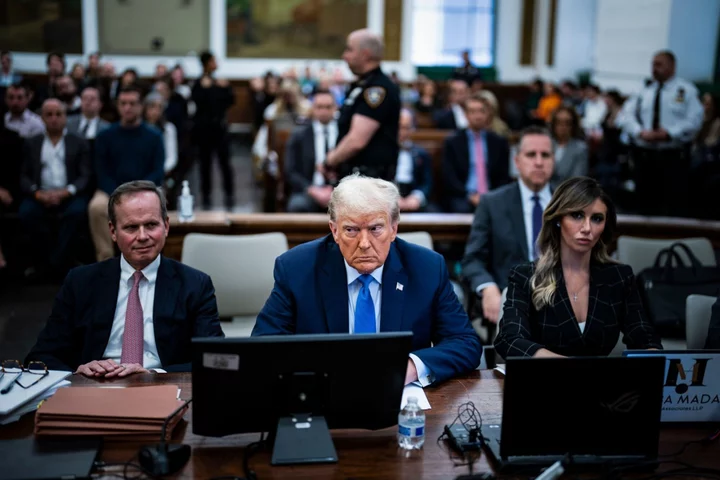As he sat on the witness stand in a New York courtroom last week, Donald Trump reached into his pocket, pulled out a piece of paper and tried to hand it to the judge.
Trump explained the document showed the standard disclaimer he used on financial records he sent to lenders — essentially saying they can’t rely on him to tell the truth. These disclaimers are likely to come up again and again in his defense case, which kicked off this week at the civil fraud trial against him.
The judge, who refused to accept the document Trump tried to hand him in court, has already rejected the disclaimer argument over and over, signaling it will be a losing strategy for the former president and his real estate business.
Read More: Trump’s full disclaimers and statements of financial condition from 2011, 2012, 2016, 2017 and 2021.
Central to the case are the statements of financial condition Trump had his accountants at Mazars USA LLP send to lenders detailing his assets and their values. The state of New York alleges he inflated his net worth by as much as $3.6 billion a year to get better terms on loans and insurance, reaping $250 million in “illegal profit” from 2011 to 2021.
Trump insists that the “worthless statement clause” included in those documents is proof enough that no fraud was committed, and that financial institutions did their own due-diligence. The argument has continuously come up in the chaotic trial over claims he defrauded Deutsche Bank AG and other banks by inflating the value of his assets.
“It says, very strongly, ‘do your own due diligence,’” Trump testified Nov. 6. “Don’t take anything from this statement for granted. You could look at the statement, but you must do your own analysis and due diligence.” He added, “If there is any mistake, the disclaimer clause covers it.”
‘Worthless’ Defense
But the judge said boiler-plate warnings about the reliability of his financial statements aren’t legally binding.
“Defendant’s reliance on these ‘worthless’ disclaimers is worthless,” state court judge Arthur Engoron wrote in September, when he found Trump liable for fraud in the case. The trial is focused on the remaining claims in the lawsuit filed by New York state — including issuing false financial statements and conspiring to falsify business records. At the conclusion, the judge will rule on liability for those claims and determine any penalties.
Engoron has rejected Trump’s argument twice — and was upheld both times by a state appeals court, once for his ruling in September and again over a January motion to dismiss. The judge said defense lawyers were argued repeatedly that a disclaimer should exonerate lies on financial documents, even though the documents “put the onus for accuracy squarely on the defendants’ shoulders.”
Disclaimers aren’t designed to be used in the way Trump has, according to John Moscow, a former prosecutor in the Manhattan District Attorney’s office. Instead, they allow borrowers the right to make minor adjustments if there’s an error in the documents they’ve submitted, he said.
“The whole point in this case is that the document as a whole was an attempt to get the bank to believe the numbers were essentially correct,” Moscow said. “Trump thought that by saying ‘only kidding’ in small type at the bottom, then that’s OK. The court disagreed. I don’t know any bankers who disagree with the court on that one.”
Trump Undeterred
So far, Trump and his lawyers haven’t been deterred. Just last week, the judge again rejected the disclaimer argument when he denied Trump’s motion to dismiss the case for lack of legally sufficient evidence.
The former president, who may return to the witness stand later, is continuing to lean into the disclaimers as his legal team starts presenting its case against the lawsuit filed last year by New York Attorney General Letitia James. The first six weeks of the trial were focused on witnesses called by the state, including Trump and his three eldest children, who worked at the Trump Organization. The proceedings could last into December.
Trump’s financial statements, which were submitted as evidence in the case, include disclaimers from Mazars that declare the asset valuations weren’t audited or verified and weren’t calculated using generally accepted accounting principles.
In a social media post last week, Trump doubled down on his argument that such warnings clear him of any liability. “This is the paper that I wanted to submit that the Judge refused to take, because he doesn’t want anyone to know about the disclaimer clause at the beginning of each Financial Statement,” he wrote.
Downplaying Documents
Kevin Wallace, a senior enforcement lawyer for the New York Attorney General’s office, spent several hours questioning Trump in court about the statements of financial condition.
Trump acknowledged he would “look at” the statements of financial condition prepared between 2011 and 2017, but he downplayed their significance. “Banks didn’t find them very relevant,” the former president testified, insisting the documents were accurate because they were prepared by his accounting firm.
The defense case, which is expected to last until Dec. 15, began Monday with Donald Trump Jr. as the first witness. Donald Trump and Eric Trump may also return to testify in their own defense after taking the stand earlier in the trial as witnesses for the state. Dates for that potential testimony haven’t been set.
Author: Greg Farrell, Patricia Hurtado and Erik Larson

